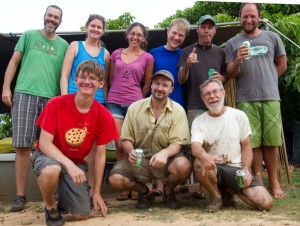Science Summer at the Cave
July 15, 2014
Research has been rampant at the cave lately…and from seven different countries!

Some of the scientists and their assistants working at the cave recently. Back row (l-r) Dr. Dennis Hansen, Emma Reed, Natasha Yamamoto, Erik de Boer, Linz Armstrong, and Rich Baxter. Front row, Reagan Reed, Dr. Nick Porch, and Dr. David Burney.
For the last few months, two grad students from the University of Zurich have been studying the role of the tortoises in helping us manage the native plant restorations. Natasha Yamamoto (New Zealand) and Lara Maspoli (Italian-Swiss) presented posters on their work at the Island Biology 2014 Symposium this week in Honolulu, attended by more than 400 scientists from around the world. Their adviser, Dr. Dennis Hansen (Denmark), has also been visiting our project, and he gave a presentation at the conference on the use of tortoises as restoration tools at Makauwahi, and compared it to sites in the Indian Ocean region where tortoises have been playing a similar role for over a century. He was accompanied by Rich Baxter (Jersey Island), former manager of the Round Island, Mauritius project which has pioneered the use of tortoises as a restoration tool. He is doing graduate work now on Aldabra Island, the only place in the Indian Ocean where giant tortoises survived the human-caused extinctions that swept through that region in the 18th century.
Meanwhile, Dr. Nicholas Porch of Deakin University in Australia has been working with me on the fossil insects in the Makauwahi Cave sediments. Nick worked with us in three past summers, under support from National Geographic, and has shown the tremendous potential of the cave’s sediments for preservation of a wide range of insect fossils. At the conference mentioned above, beetle expert Dr. Jim Liebherr gave a talk on the remarkable beetle fossils that Nick and I have excavated from the cave.
Some of you may remember Emma Reed, a student from Cornell who worked with us last year on the fossil snails from the cave. She and her brother Reagan have been back in recent weeks to wrap up her work. Our recent excavations have provided the additional snails she needs for a publication that looks at the scars of rat predation on the snails and shows that, after human arrival, snails suffered from the introduced rats and in some cases went extinct soon after.
Erik de Boer, a Dutch colleague who is collaborating with me on our National Geographic-sponsored project on Rodrigues Island in the Indian Ocean, has been visiting in order to learn the techniques developed at the cave for excavating below the water table. We hope to apply this methodology to sites on Mauritius and Madagascar next year that can help us better understand the past ecology of those islands.
A few days ago, we also showed around three more Dutch scientists, including Dr. Kenneth Rijsdijk, who has spearheaded the work in recent years at Mare aux Songes, the famous Dodo site on Mauritius, a place with preservation similar to Makauwahi Cave.
It’s been a great time lately to visit the cave if you want to see excavations in progress and meet some of the world’s most important scientists doing this type of work.
Comments:
cathy ansdell on July 30, 2014
thanks for the update, we enjoyed a visit to the cave with David Burney last march, quite by accident, as we met on the road going somewhere else. One of the highlights of our 2 weeks on Kauai. Its nice to know there are people like you all who look after the planet for the rest of us. Thank you again. Cathy and Ron ansdell